Damascus, perhaps the oldest inhabited city in the world
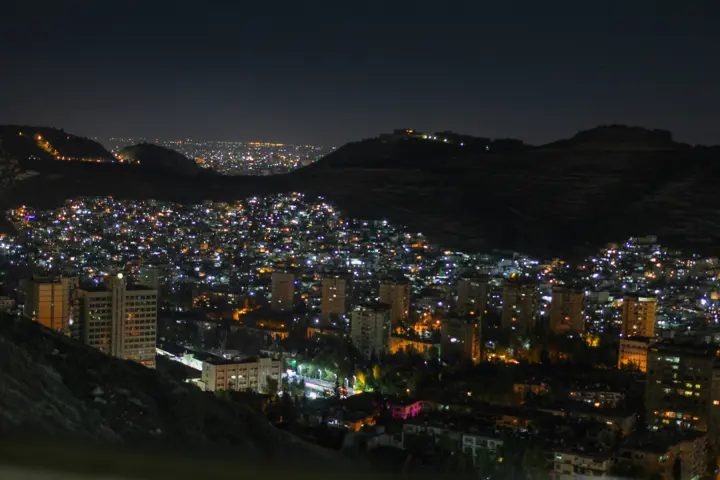
The city of Damascus is located in southwestern Syria, close to Lebanon (100 kilometers from Beirut), Jordan (150 kilometers from Amman), Palestine (about 100 kilometers from Haifa), and on the northern border of the Levant desert. Damascus and its plain are surrounded by highlands, like a wristband, almost from the north, west and southwest, leaving to the east overlooking the sprawling Levant desert stretching as far as Iraq and Saudi Arabia. This location provides the city of Damascus with a mild climate in winter, and a pleasant and fresh air stream that blows in summer from the west through the opening of the Barada River valley, which feeds Damascus with water and branches into seven branches in its fertile plain known as the Damascus Ghouta, which was and still produces the finest types of vegetables and fruits, despite its limited area, which is approximately the area of a radius of about 25 kilometers. Perhaps this location, climate, abundance of water and fertility of the land explain the emergence and continuation of life in the city of Damascus thousands of years ago.
Recommend
Show key points
- Damascus’s strategic location near Lebanon, Jordan, and Palestine, along with its fertile Ghouta plain and Barada River, has contributed to its mild climate and long-standing habitation for thousands of years.
- The city's name has various interpretations tied to mythology, astronomy, and local geography, and it holds religious significance as the "land of the prophets" where many key religious figures have ties.
- The Old City of Damascus, enclosed by Roman walls with seven distinctive gates, is rich in historical architecture and is home to iconic landmarks like the Umayyad Mosque built on layers of ancient religious structures.
- ADVERTISEMENT
- Notable sites in Damascus include the Al-Azm Palace, the Damascus Citadel, and various traditional markets and houses, showcasing refined examples of Damascene architecture and lifestyle.
- Damascus is renowned for its traditional crafts and industries such as silk brocade, jewelry, copperware, and inlaid woodwork, which have historically been exported and admired around the world.
- Over the centuries, Damascus has grown from a small walled settlement to a metropolis with nearly 10 million inhabitants, expanding into the surrounding Ghouta, which remains a popular recreational area.
- Widely known for its diverse cuisine and elaborate sweets, the city also enjoys a vibrant cultural scene with theaters, museums, international cultural institutions, and was named Arab Capital of Culture in 200
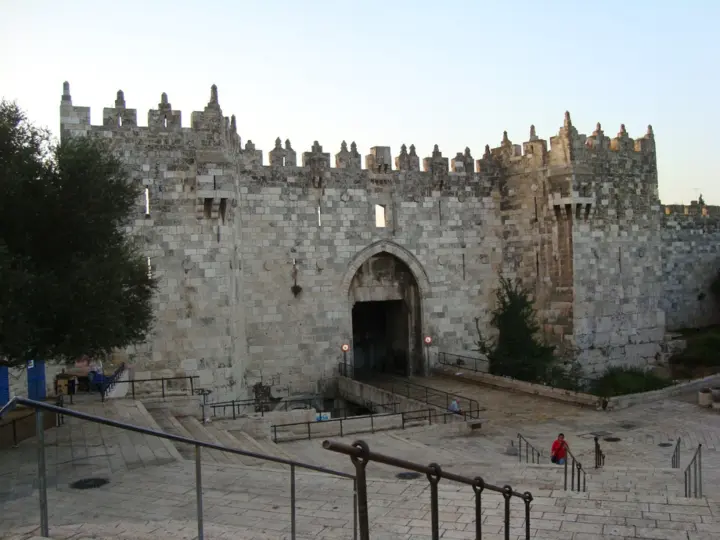
There are many meanings and connotations about the name of the city, some attribute it to the wife of the Greek water god Damakina, some establish the association of this name with the sun (sun), one of the children of Aram (Mash), and some see a connection with the face mole, as the city of Damascus and its Ghouta represent a mole on the face of the surrounding desert. Damascus is mentioned on the wall of the temple of Karnak during the reign of Thutmose III around 1468 BC, but evidence indicates that settlement there has been stable since about 9000 BC. Some call Damascus the land of the prophets, due to the multiplicity of messengers and missionaries who lived or passed through it, such as Uz, a grandson of the Prophet Noah, the shrine of Adam on Mount Qasioun next to the city, and the cave of the Barzeh region where the prophets Abraham, Moses, Jesus, Lot and Job took refuge to pray.
The oval-shaped Old City of Damascus, which covers an area of about 128 hectares, is surrounded by walls on all sides, with a castle and seven Roman gates bearing the following names: Bab al-Saghir, dedicated to Mars; Bab al-Faradis, dedicated to the planet Mercury; Bab al-Salam, dedicated to the moon; Bab Thomas, named after St. Thomas the Apostle; An eastern door on the eastern side of the city, preserved in its Roman form without restoration, which refers to the sun; Bab Kisan, dedicated to Saturn, named after one of the guards of the Umayyad caliph Muawiyah; and finally Bab al-Jabiya, dedicated to Jupiter, is named after the village of Jabiya, which is the counterpart of the eastern gate and between them is the straight street, the longest street in the world when it was built.
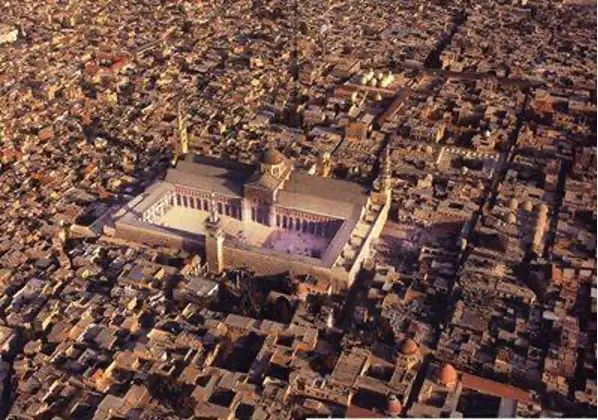
In the center of the center of Old Damascus, the Umayyad Mosque built on the site of the temple of Hadd, which became the temple of the god Jupiter in the days of the Romans, and then the Church of John the Baptist, and finally the magnificent Umayyad Mosque as a result of an agreement between the caliph Al-Walid and the Christians. The mosque is bordered to the south by the Al-Bazuria neighborhood, to the west by Souq Al-Hamidiya, to the east by Al-Noufra Café, and to the north by the Azizia School and the tomb of Sultan Salah al-Din al-Ayyubi. The area of the mosque is about 97 * 157 square meters, and is divided into the covered sanctuary section and the open courtyard (courtyard of the mosque). The mosque is famous for its three minarets: the minaret of the bride in the north, the minaret of Jesus in the east, the minaret of Qaitbay in the west, and the dome of the eagle over the sanctuary, which contains the tomb of the Prophet John the Baptist. The courtyard is distributed by the dome of the watches, the dome of the treasury, and the dome of ablution or blessing. Perhaps the most prominent aesthetics of this mosque are the mosaics that cover the façade of the sanctuary and some walls overlooking the courtyard. These paintings represent scenes from the promised paradise. The construction of the Umayyad Mosque took about nine years, and the construction costs amounted to about five million six hundred gold dinars, which is equivalent to the production of the Levant seven years.
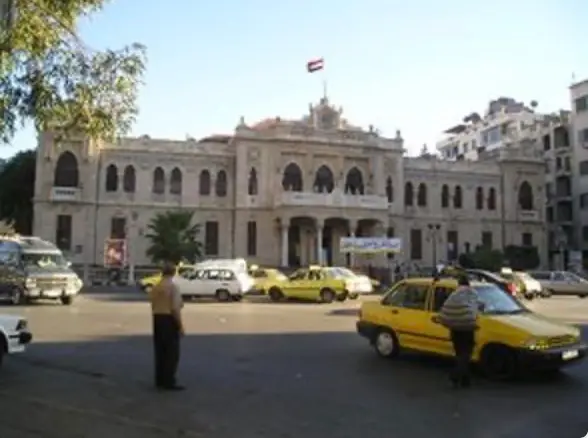
The city of Damascus hosts many other historical monuments, perhaps the most prominent of which are Al-Azm Palace, the Sulaymaniyah Tekke, the Damascus Citadel, Khan Asaad Pasha, the Anania Church, the Marian Church, the Midhat Pasha Covered Market, the Hamidiya Covered Market as well, a number of public archaeological baths, a number of typical Damascene houses, the Virtual Library, and the Hijaz Station. Al-Azm Palace reflects the architectural architecture of the Damascene house in terms of the distribution of rooms, halls and services on two floors, lower and upper, and the outdoor spaces (courtyard) with its plants, especially jasmine, jasmine, citrus citrus, lemons, citron, water fountains and lakes, and the constant keenness to provide comfort and relaxation for residents and guests. It is remarkable that the exterior of the Damascene house does not show its interior aesthetics. Among the most prominent Damascene houses, the most famous of which are the house of Khaled al-Azm, the house of Ahmed al-Sibai, the house of Nabulsi, the house of Quwatli, the house of Dahdah, and the house of the teacher. These high-end houses fascinated the travelers who flocked to the Levant.
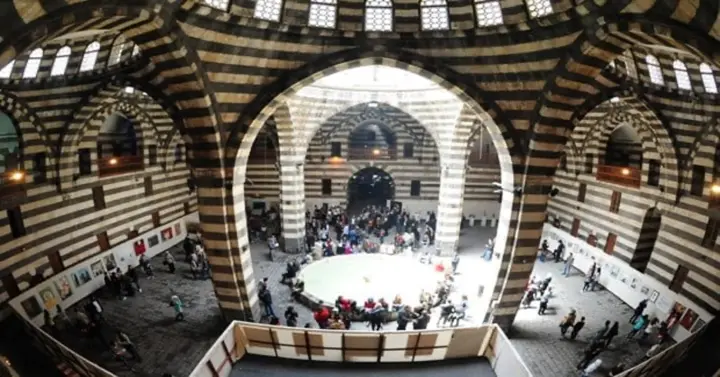
Like many cities in the east, Damascus is famous for its specialized markets, such as the Gold Souk, the Bazuriyeh Market, the Wool Market, the Silk Souk and the Copper Market, among others. Damascus also embraces many crafts such as copper engraving, gold, silver and jewelry making, paintings, boxes and wooden boxes inlaid with mother-of-pearl or mosaic (small pieces of stone, marble, mother-of-pearl or metal paved next to each other and glued), dried fruits, Damascene swords, carpentry and paint, and brocade fabric made of silk threads inlaid with gold threads (damqs from the word Damascus). It is known that Queen Elizabeth II wore at her wedding a robe of this fabric. Syria also historically occupied a prominent place in silkworm breeding and silk production until the beginning of the twentieth century, when this craft began to decline due to the spread of synthetic threads.
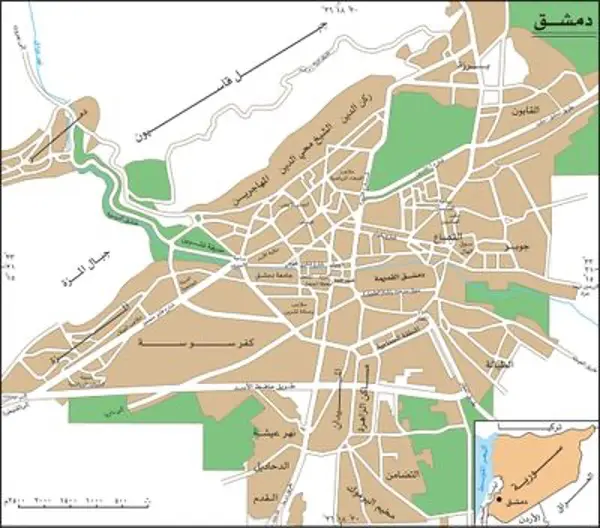
Until the eighteenth century, Damascus was confined to the Old City within the walls and the Midan neighborhood outside it, with a population of about 100,000. With the necessities of expansion, construction began outside the walls, and there are neighborhoods inside the walls, and others outside them, such as the inner Amara neighborhood, the external architecture neighborhood, the internal Al-Shaghour neighborhood, and the outer Al-Shaghour neighborhood. In the mid-twentieth century, Damascus had a population of about 500,000. Now, its population is approaching 10 million, with urban expansion at the expense of Ghouta.
As mentioned above, the Ghouta of Damascus surrounds the city from almost all sides, and this Ghouta represents a natural outlet for the city, where people go out on holidays to its outskirts with all the necessities of preparing food, sitting and relaxing to spend a whole day in the lap of nature and under the shade of lush fruit trees, and return in the evening to their homes. One of the most prominent areas of recreation near Damascus, the Rabwa area, near the city, is one of the most important, where restaurants and cafes are spread several kilometers away on both sides of the Barada River Valley between Damascus and Dahi Dummar.
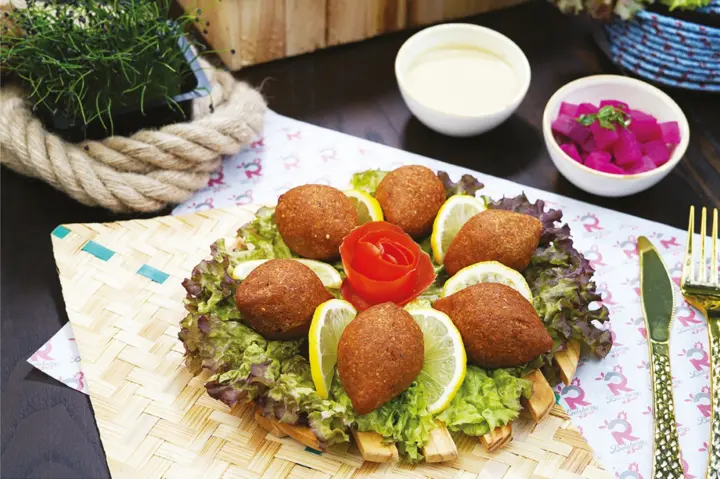
With regard to Damascene food and cuisine, this city is famous for a number of dishes, perhaps the most important of which are stuffed vegetables such as zucchini, eggplant and pepper, kibbeh (a mixture of bulgur and soft meat mixed well, kneaded, formed and stuffed with a mixture of meat and onions) of all kinds, and various salads such as tabbouleh, fattoush, baba ghanoush, pickles, delicious lamb grills and various chickens. The dining table is not without about ten appetizers and salads, the main course, rice, vegetables and desserts. There are many types of home confectionery or traditional craftsmanship, even serving as an industry that meets local demand, exporting its products to all parts of the world. Among the most prominent of these sweets are Kunafa and Mabrouma, Kul Washkr, Harissa, and Madlouqa. These sweets combine raw materials of flour, ghee or butter, sugar and nuts such as pistachios, almonds, walnuts and hazelnuts, giving them a wonderful flavor, taste and colors.
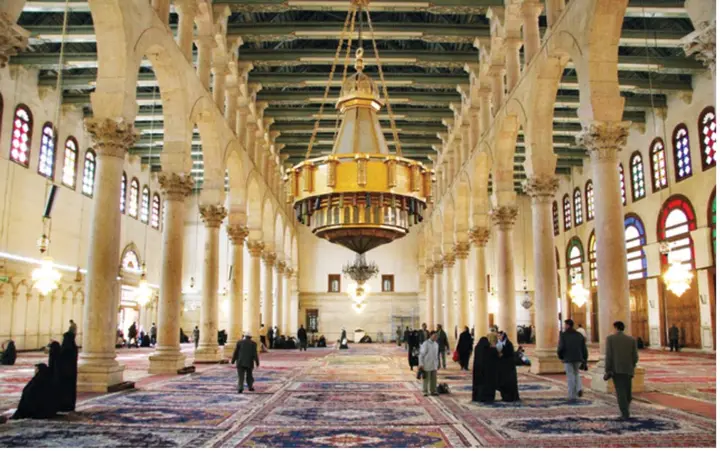
Throughout history, Damascus has occupied a prominent place religiously, economically and politically, and Damascus has been mentioned many times in the heavenly books from the Torah to the Bible and the Holy Quran. When Damascus is mentioned to the Turks, the word Sharif is always added, and they say Sham Sharif. For Christians, Damascus is the path of guidance and faith in the footsteps of St. Paul the Apostle, who came to Damascus as an atheist and came out of it preaching Christianity. Hence the importance of the visit of the Pope of Rome to Syria in the nineties of the twentieth century. In this context, in Old Damascus in particular, and in Syria in general, all sects of monotheistic religions coexist, where their followers practice all their beliefs in their own places of worship, and all their family and social customs and traditions. They also share their own occasions and holidays. At the official level, the holidays of these religions are considered national holidays and an official holiday of the State, and the school curricula include courses for teaching religious culture to followers of each religion. Citizens are equal in rights and duties irrespective of their religious affiliation, and public office of all ranks, with the exception of religious functions, is available to all citizens without discrimination. In all eras, you will find politicians and figures, poets and writers, doctors, engineers and artists of all denominations.
Damascus embraced the most important civilizations and lived in the most important celebrities in history, literature, poetry, thought, culture, astronomy, clerics, jurisprudence, Islamic and Christian religious sciences, medicine, pharmacy and others, in addition to kings, princes and sultans. It houses the historical houses of science, its centers and schools that have been visited by seekers of science and knowledge throughout the ages.
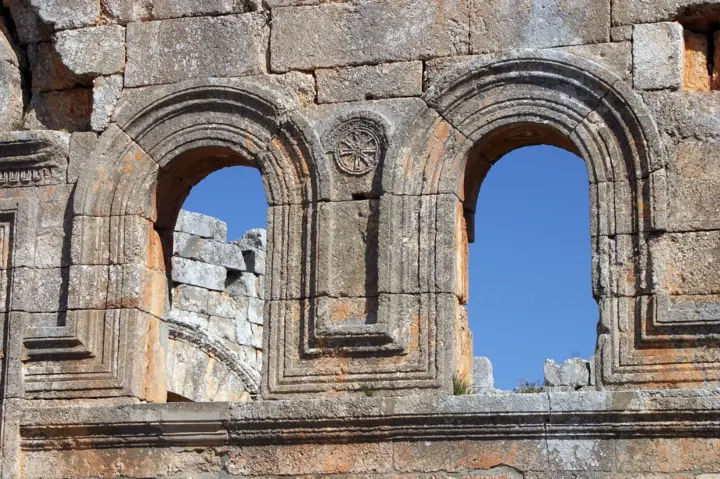
Damascus is the capital of culture through a long history full of literature, and many cultural activities are held in it, and many local and international cultural centers are spread in it such as the French Cultural Center, the Spanish Cultural Center, the Russian Cultural Center, and the German Cultural Center. There are also many theaters, cinemas and specialized museums such as the Damascus Museum and the Arabic Calligraphy Museum. An important cultural landmark of the city is Dar al-Assad for Culture, the Syrian Opera House and others.Damascus has a rich national cultural heritage of publications in the fields of culture, literature, poetry, science, music and art, making this city the capital of culture, Damascus was chosen - the capital of Arab culture in 2008.
Thus, Damascus remained faithful to its history, and its position as a cultural and intellectual crossroads, a center of civilizational radiation, and a melting pot of multiple cultures in the service of a comprehensive humanitarian mission. Damascus also continues its economic role as a center of communication and exchange between peoples and nations on the path of development and prosperity.








